
 According to Deputy Secretary-General Jan Eliasson at UNEA-2, “Environmental concerns must be addressed in a much more integrated and horizontal way as they are inextricably connected to economic considerations, to social development, to human rights, to the rule of law and matters of peace and security”, and Sustainable development depends on an equitable distribution of resources for today and for the future. It cannot be achieved without gender equality. Women empowerment is a key factor for achieving sustainable economic growth, social development and environmental sustainability. It is based on the principles of democracy and the rule of law and respect for fundamental rights including freedom and equal opportunities for all. It brings about solidarity within and between generations. It seeks to promote a dynamic economy with a high level of employment and education, of health protection, of social and territorial cohesion and of environmental protection in a peaceful and secure world, respecting cultural diversity. “What we are doing to the forests of the world is but a mirror reflection of what we are doing to ourselves and to one another”. – Mahatma Gandhi, and the theme of this year is “Join the race to make the world a better place”.
According to Deputy Secretary-General Jan Eliasson at UNEA-2, “Environmental concerns must be addressed in a much more integrated and horizontal way as they are inextricably connected to economic considerations, to social development, to human rights, to the rule of law and matters of peace and security”, and Sustainable development depends on an equitable distribution of resources for today and for the future. It cannot be achieved without gender equality. Women empowerment is a key factor for achieving sustainable economic growth, social development and environmental sustainability. It is based on the principles of democracy and the rule of law and respect for fundamental rights including freedom and equal opportunities for all. It brings about solidarity within and between generations. It seeks to promote a dynamic economy with a high level of employment and education, of health protection, of social and territorial cohesion and of environmental protection in a peaceful and secure world, respecting cultural diversity. “What we are doing to the forests of the world is but a mirror reflection of what we are doing to ourselves and to one another”. – Mahatma Gandhi, and the theme of this year is “Join the race to make the world a better place”.
Sustainable Development is broadly defined as development which meets the requirements of the present without compromising the ability of future generations to meet their own needs. Sustainable Development should be a key principle of all policies and actions, which are broadly designed to create a society which is based on freedom, democracy and respect for fundamental rights, fostering equality of opportunity and solidarity within and between generations.
The sustainable development should be based on balanced economic growth and price stability, a highly competitive social market economy, aiming at full employment, a high level of education and social progress, and a high level of protection and improvement of the quality of the environment, should be a key objective for all national policies, and should aim at the continuous improvement of the quality of life on earth of both current and future generations. It is about safeguarding the earth’s capacity to support life in all its diversity.
Viewed in a broad spectrum, women have played a vital role in the global environmental movement. The World Commission on Environment and Development, in its report entitled Our Common Future, published in 1988, linked the environmental crisis to unsustainable development and financial practices that were worsening the North-South gap, with women a majority of the world’s poor and illiterate.
Over the years, women have continued to speak out for policies and practices that do not threaten the health and well-being of future generations. They continue to fight for improved living standards and protection of the environment. In almost all countries, women are disproportionately represented among the poor. And studies have found that the poor, in urban and rural areas of rich and poor countries, bear the greatest burden of environmental degradation and pollution.
Women share the primary responsibility for nutrition, child care and household management in almost all countries. They are also active in environmental management. In most developing countries, women play a major role as farmers, animal tenders, and water and fuel collectors. Yet, despite their roles, women are not adequately represented in the decision-making processes related to the issues of environment and development at local, national or international levels.
Having their expertise, knowledge and perspective been overlooked for years, women are now demanding that their voices be heard. They recognize that an integrated approach to sustainable development is necessary since political, economic, social and environmental issues are closely interlinked.
Women took active part in the Rio Earth Summit process and succeeded in obtaining a chapter on women and sustainable development and over one hundred references and recommendations pertaining to women in the final agreement, Agenda 21. The 1992 Rio Summit, together with the 1993 Human Rights Conference, the 1994 International Conference on Population and Development, the 1995 Social Summit and the 1995 Fourth World Conference on Women, have focused the work of the United Nations on the environment, population, human rights, poverty and gender, and the relationships between these issues.
In Rio, women were considered a “major group” whose involvement was necessary to achieve sustainable development. Today, there is a growing emphasis on “mainstreaming”– integrally incorporating women’s concerns and participation in the planning, implementation and monitoring of all development and environmental management programmes to ensure that women benefit. The United Nations system is in the process of mainstreaming a gender-perspective in its work.
The Fourth World Conference on Women held in Beijing in September 1995, emphasized that empowerment, full participation and equality for women are the foundations for peace and sustainable development. The plan also acknowledges that sustainable development policies that do not involve women and men alike will not succeed in the long run.
Women and Poverty
According to broad estimates, more than one in five people around the world live in conditions of extreme poverty on little more than $1 per day. In all developing regions except East Asia, the number of poor people has been rising since the 1980s. Studies indicate that the gaps between rich and poor are widening, and that the majority of the world’s poor are women. Since the 1970s, the number of rural women living below the poverty line has increased by 50 per cent, in comparison with 30 per cent for men.
Women accrue less income than men over their lifetime for a variety of reasons. They get paid less for the same work and are more likely to work less in order to reconcile their careers with child or elder care. These gaps in women’s employment history reduce the amount of social security women gain. It also decreases the likelihood of receiving credit or loans. All these facts increase women’s vulnerability to poverty, especially in old age. Governments must introduce policies, programmes and quota systems which correct this imbalance.
The United Nations Development Programme has defined sustainable development as development that not only generates economic growth but distributes its benefits equitably, that regenerates the environment rather than destroying it, and that empowers people rather than marginalizing them. It is development that gives priority to the poor, enlarging their choices and opportunities and providing for their participation in decisions that affect their lives.
Many women’s groups are concerned that current patterns of economic development and globalization are increasing the gap between rich and poor, benefiting men more than women, and leading to increased environmental degradation. One report published by the Women’s Environment and Development Organization (WEDO), “The imperatives of the global economy seem to be outrunning the post-Rio agenda five years later. How to bring them into closer step is the current challenge.” Women are calling for gender-sensitive research in this area. They are also calling for increased access to resources–land, credit, education, technology and information–so that they can participate equally with men in key decisions that affect their lives and all life on planet Earth.
Women have also raised demand that Governments establish new forms of economic accounting to include women’s unpaid work and promote public policies that will reduce the disproportionate time women spend working, which is often twice as much as men.
Management of Natural Resources
In almost all developing regions, women are often the primary users and managers of land, forest, water and other natural resources. Women in rural areas of developing regions spend major parts of their day growing food, gathering fuel wood, cooking and carrying water.
Women are responsible for most local food production in Africa and Asia. Consequently, they are responsible for the selection of seeds, fertilizers and pesticides and the maintenance of productive soil to nourish seedlings and plants. Women are also users, preservers and managers of biodiversity. Research on 60 home gardens in Thailand revealed 230 different species — many of which had been rescued from a neighbouring forest before it was cleared.
Indigenous women have a special relationship to natural resources. Their cultures and practices promote a balanced, respectful use and preservation of natural resources so that future generations can meet their needs. Yet most development schemes today ignore the needs and practices of indigenous peoples.
As consumers and producers, caretakers of their families and educators, women play an important role in promoting sustainable development through their concern for the quality and sustainability of life for present and future generations. However, due to discrimination, many women are unable to exercise their full potential in natural resource and environmental management, given their lack of training, status, land and property rights and capital.
Women and Water
In rural areas in most developing countries, women are the managers of water resources — often walking miles to fetch water for basic household chores. In some parts of Africa, women and children spend eight hours a day collecting water. The proportion of rural women affected by water scarcity is estimated at 55 per cent in Africa, 32 per cent in Asia and 45 per cent in Latin America.
Access to safe water is also an issue of increasing concern for urban women and families. Poor water access and quality affect not only women’s crop and livestock production and the amount of labour they must expend to collect, store and distribute water, but also their health and that of their families. Water-borne diseases such as cholera, dysentery, typhoid, malaria and diarrhoea claim millions of lives each year. Parasitic diseases, such as onchocerciasis (river blindness), are also spread through contaminated water.
However, despite their responsibility for water collection and sanitation management, women rarely participate in decision-making when the construction of facilities is planned. All too often they have no say about the location of a pump or the design of latrines. It is now recognized that the exclusion of women from the planning of water supply and sanitation schemes is a major cause of their high rate of failure. In order to improve health and quality of life for women, water and sanitation programmes must concentrate on reducing the time and energy women expend in water collection, and increasing women’s participation in community decision-making regarding water and sanitation.
Efforts must also be increased to ensure access to safe water. According to broad estimates, currently more than one billion people in developing countries do not have access to safe water.
Conclusion
Women’s contribution to sustainable development must be recognized. Women have a strong role in education and socializing their children, including teaching them care and responsibility with regard to the use and protection of natural resources. More should be done to increase women’s voice in environmental decision making and to enable women to seize opportunities in the “green economy”. More capacity building programmes and training tailored to the needs of women are needed. In order to build women as catalyst for sustainable development, their role in family, community and society at large has to free from socio-cultural and religious traditions that prevent women participation. There is need for change of mindset, especially of the males who dominate the scene.
*By Dr. Arvind Kumar, President, India Water Foundation, New Delhi



